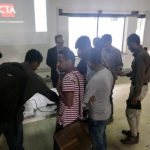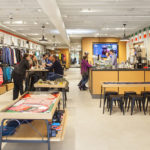Pair of CTA Projects Win 2018 Awards from Idaho Smart Growth
Idaho Smart Growth honored the recipients of 2018 Grow Smart Awards at its annual awards celebration earlier this month. This year’s program highlighted the importance of urban renewal tools in advancing smart growth projects in Idaho, with a special focus on the Boise Central Urban Renewal District, the state’s first. For the past 14 years, Idaho Smart Growth has presented the Grow Smart Awards to recognize projects and plans from around the state that are excellent examples of smart growth in action. Award nominations are reviewed and selected by a jury of experts for their application of smart growth principles.
Two projects of which CTA was a part were among this year’s honorees. The Garden City Artisans Wayfinding project encourages connections among Garden City visitors, residents, artisans, businesses and other amenities through graphic design, signs, and maps. Strong collaborations help this community stake out a unique identity. Renovation and expansion of Mountain West Bank’s State and 16th Street branch in downtown Boise improved walkability, accessibility, sustainability, and connectivity while adding to the neighborhood’s sense of place.
Learn more about the projects below.
Mountain West Bank — State and 16th
The renovation and expansion of Mountain West Bank’s State and 16th Street branch intended first and foremost to bridge the gap between the bank’s condition and the neighborhood’s sense of place. Mountain West Bank maintains a quality of professionalism, friendliness, and comfort, and although this particular branch was widely known and well-frequented, the building itself was ill-suited to these standards. Residing in Boise’s highly-walkable and community-oriented North End also calls for a certain character which was previously unanswered. Ultimately, the renovation and expansion of Mountain West Bank State Street was designed with a sensibility for the scale of the neighborhood along with priorities of walkability, efficiency, and community.
READ MORE
Development of the neighborhood-appropriate bank was guided by the goal of accessibility and approachability for nearby patrons and residents. Patrons should feel comfortable coming in and out of the bank with ease, especially on foot. Traffic patterns were improved by creating a one-way access point off State Street and reducing the number of access points to the motorway, both of which streamline the flow of traffic and decrease congestion on the street. Improvements to ACHD Right-of-Way included the installation of sidewalk ramps and traffic lane dividers at the cost of Mountain West, a representation of their commitment to accessibility and ease of travel. Finally, by addressing the sidewalk rather than the street, the building positions its ATM and main entrance to be most easily accessible to pedestrians, setting the precedent of walkability over high vehicular traffic.
The parking lot, rather than taking up valuable real estate in front of the bank, is tucked behind the building to contribute to the beautification of the neighborhood and to invite regulars and newcomers to meander inside. Its location — which grants locals the option of stopping by the bank on the way to nearby restaurants, markets, and, of course, their homes — is also a key component to ensuring of a walkable community. It should be noted, too, that Mountain West, its staff, and the design team are proud to tap into the city bus route, and are advocating to expand the radius of Boise Green Bike to encompass State and 16th Street, and install a Green Bike hub outside the bank.
The bank’s development sought fair, innovative, and cost-effective decisions. Primarily, despite conversations to demolish and rebuild the branch or move it to a new location entirely, designers introduced the idea to instead add to the branch’s existing architecture. In one fell swoop, this decision avoided many potential problems including the high cost of demolishing and rebuilding the central vault and the logistical complications of temporarily relocating without compromising secure access to safety deposit boxes.
By foregoing an expensive total re-construction, old and new were efficiently fused to provide depth and dimension to the building’s facade and interior. Though the final construction may initially seem like a complete rebirth, side-by-side comparison reveals the core of the original building remains intact, seamlessly wrapped with the addition. Additionally, the historic neighborhood’s aesthetic and the existing architecture were honored — including the installation of historic streetlights as well as additional greenspace to improve pedestrian safety and overall beauty — and the lot’s beloved trees were preserved and protected. Between the addition and the new sources of daylight, many have stated the building feels three to four times larger despite being barely twice its original size, a feat achieved by resisting the construction of an inappropriately enormous behemoth in the middle of the North End.
These decisions were made amidst multiple meetings with stakeholders, during which the goals of engaging the pedestrian experience, designing appropriately for the neighborhood, and creating a building that the neighborhood would be proud to call its own were established. Additionally, a public hearing was held for community members to share feedback and concerns. Though a similar meeting for a nearby development drew crowds of vocal naysayers, Mountain West’s proposal didn’t elicit a single concern — a hearty stamp of approval from such an engaged neighborhood.
At the branch’s May 18 ribbon cutting, positive buzz from the Mountain West team and their patrons, as well as members of the Boise Metro Chamber of Commerce, was in the air. In general, people were overwhelmed by the improvements to the bank’s aesthetic and function, but, as one attendee noted, “You might think it’s always been here if you didn’t know any better.” Another attendee mentioned he had passed the old building for years without giving it a second look, and now he can’t take his eyes off it. We believe this speaks to the idea that the Mountain West renovation and addition does something special: it simultaneously stands out while fitting in, in the best way possible.
Garden City Artisan Path Wayfinding
Garden City, ID, is narrow and long, stretching westward for miles from the Boise Connector, a stretch of highway linking Interstate 84 with downtown. Its name is inspired by the Chinese migrant workers who made their livelihood by selling produce, from strawberries to sweet onions, which they grew in row-crop gardens. According to lore, when Ada County commissioners named Garden City as its own municipality, entrepreneurs took advantage of the new entity by lining the city’s main boulevard–Chinden, which is a portmanteau of China and Garden–with gambling houses, which Boise had just banned.
READ MORE
Today, with the city’s namesake gardens gone and gambling houses shut down, Garden City is fighting against the unfortunate idea that it lacks personality, that it is nothing more than the connective tissue between Boise and Eagle. Advocates of Garden City are convinced the city is on the precipice of a renaissance, or, at the very least, a profound discovery of what the area has to offer.
As real estate prices in Boise skyrocket, many young people and artists are turning to Garden City, which is only a few minutes’ walk along the river from downtown Boise, for affordable living and working space. Established residents and businesses, too, are experiencing a renewal in energy as they are stimulated by this opportunity for growth in Garden City commerce and culture.
Looking to capitalize upon and propel this excitement, city commissioners arranged a grant to assist local organizations working to improve the health and welfare of the city’s residents. Three CTA team members–business development representative Danielle Hurd and architects Lindsay Erb and Amy Lindgren–each proposed projects including, respectively, a gateway entrance delineating the district for east- and westbound traffic on Chinden Boulevard; newly installed, colorful sidewalks; and a wayfinding infographic for Garden City’s Surel Mitchell Live-Work-Create district.
Although none of CTA’s proposed projects were selected for this particular grant, the Garden City Urban Renewal Agency recognized potential in the ideas and the prospect of developing a relationship with the firm, so they inquired about the possibility of working together, separate from the initial grant. With an enthusiastic yes, team members from CTA and officials from Garden City brainstormed how they could make use of expertise in visual design, the flow of bodies, and spacial environments for Garden City.
Eventually, the two entities co-developed and co-funded a project (with support from the Riverside Hotel, the Idaho Wine Commission, and COMPASS) to highlight the city’s burgeoning artisan presence and attitude: the Garden City Artisan Pathway. The idea was to install a mapped network of visually striking signs along the Garden City segment of the Boise greenbelt, a safely walkable riverside path extending along the edge of Garden City, tucked away from heavy traffic. The goal of the signs would be to catch the attention of walkers, runners, and cyclists who might only utilize Garden City for the greenbelt, and guide them to venture into the city as a destination of its own.
The nine full-sized signs, eventually designed by CTA graphic designer Lisa Guerrero, direct passersby to over 30 local businesses and community spaces, categorized as either Taste (artisan wineries, breweries, etc.), Create (artist galleries and studios), or Play (parks and other recreational areas). An explanatory sign with dispensable paper maps sits at the base of the path to help those who meander from the greenbelt find their way from place to place, and a banner hangs over Chinden Boulevard to encourage passing traffic to consider Garden City as more than a passageway, and invite them to venture into the city.
The group of businesses, studios, and parks included in the project must complete a relatively thorough application and fit a specific set of conditions. The city is intentionally discerning with potential applicants to ensure the included projects are genuinely artisan, accessible and friendly to the public, and embodying the essence of Garden City. Many of the local artists and businesses display the corresponding graphic–Create, Taste, or Play–in their window to celebrate their role as a member of Garden City’s growing community.
Both as a firm and a collection of private area residents, CTA is thrilled that Garden City is declaring itself a distinct and vibrant area in the Treasure Valley, and is proud to be a part of the city’s development.


